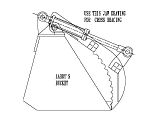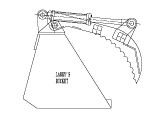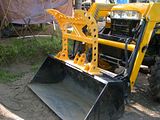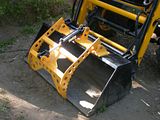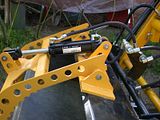Scotty has shown the two most important positions.
The first is when the grapple is fully closed against your bucket lip or toothbar. That's when the cylinder is fully extended.
-Pick a point above the grapple jaws which represent your cylinder attachment (pivot) on the grapple jaws.
-Draw a radius using your fully extended cylinder dimension from the center of that point.
-See where that arc goes when it goes above your top bucket lip.
-You can then pick a spot on that arc (above your bucket top lip) that will be the position of the bucket pivot.
The second is when the cylinder is fully retracted. After you've picked those two pivots, see where that first pivot (the one on the grapple jaws) ends up with the clinder fully retracted.
-You can do that by drawing a radius from that bucket top lip pivot using the fully retracted cylinder dimension.
-Rotate the grapple jaws up until the grapple jaw pivot intersects that radius.
-That's where the jaw will be (fully open) when the cylinder is fully retracted.
You may have to repeat the first two steps if you don't like where your grapple ends up when the cylinder is fully retracted. You may need to pick another first pivot spot on the grapple jaws to get a desirable condition when the grapple is fully opened. Here is an example of the bucket grapple I designed for my buddies. They wanted as much opening as possible. So I had to move the first (and consequently the second) pivot point until I got what I wanted.
Hope that helps and is not confusing.
Rob-
